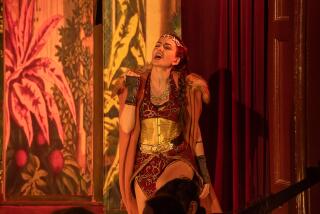MUSIC REVIEW : Ensemble Offers a Riveting Look at Medieval Pageants
- Share via
SAN DIEGO — Can music drama from the 12th Century have the emotional tug of verismo opera and the dramatic punch of Brechtian theater?
At St. Paul’s Episcopal Cathedral on Tuesday night, Frederick Renz’s Ensemble for Early Music gave that unlikely theoretical question a decidedly affirmative answer.
The troupe of 20 New York City musicians, all singers except for three instrumentalists, performed “Herod and the Innocents,” a conflation of two medieval mystery plays based on the biblical Nativity narratives. In this piece, singing shepherds and Magi visit the Holy Family, and Herod oversees his vengeful infanticide to stirring musical cadence.
With a minimum of props and set, but a highly imaginative repertory of stylized gesture and liturgical procession, the ensemble gave a riveting, vivid account of these medieval pageants.
“Herod and the Innocents” could hardly have found a more sympathetic setting than the local cathedral. When the players entered singing in slow procession through the darkened church, they heightened the dramatic expectation significantly. And, when the angel-narrator sang perched on the triple-arch set, with the cathedral’s half-finished organ facade as backdrop, the montage of sacred symbols was indeed striking.
Although the music in the 12th-Century play manuscripts is exclusively vocal and primarily monophonic, like Gregorian chant,Renz’s ensemble elaborated the musical fabric with polyphonic fragments and continuous but discreet instrumental accompaniment. Unlike the ethereal chant as practiced by the monks of Solemnes, however, the style of most of this singing was rhythmic and highly inflected.
From a purist’s perspective, the Ensemble for Early Music under Renz’s direction courted inconsistencies.
True to the period, it employed only male voices for this ecclesiastical art form. The sole female, Gabrielle Brite, played the non-singing role of Mary, and Rachel’s extended lament over the murdered innocent children was passionately sung by countertenor Douglas Stevens. But the lute and hammered dulcimer interpolations, as evocative as they sounded, would not have been likely instruments for a church function.
The highly dramatic lighting, designed by Robert Graham Small, was also a distinctly modern accommodation.
Notable singers were David Frye as the archangel, whose resonant tenor voice gracefully filled the cathedral, and Stevens, whose countertenor instrument was both penetrating and lyrical. Peter Becker had the passion for Herod’s deranged malevolence, but his weak bass-baritone did not adequately support his character.
The performance concluded with the moving Gregorian “Te Deum” sung by a procession that snaked through the cathedral aisles.
More to Read
The biggest entertainment stories
Get our big stories about Hollywood, film, television, music, arts, culture and more right in your inbox as soon as they publish.
You may occasionally receive promotional content from the Los Angeles Times.










